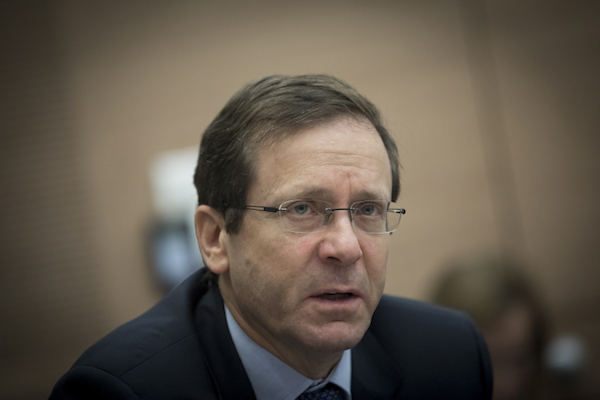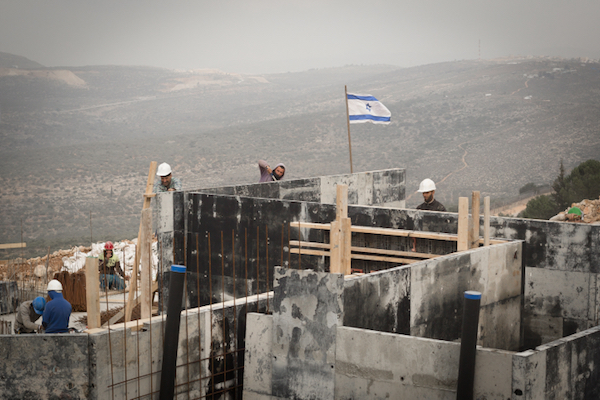The thinking behind Isaac Herzog’s 10-point peace plan is the inevitable result of the unequal relationship between an occupying power and an occupied people. It is based entirely on Israel’s concerns, not on any notion that Palestinians have inalienable rights and are entitled to the same freedoms as everyone else.
By Mitchell Plitnick

Israeli opposition leader Isaac Herzog, head of the Labor party, issued a “10-point plan” for a restarted peace process this week. His stated goals in doing so are to stave off the Israeli right’s drive toward annexation of the West Bank, to preserve the settlement blocs, to end Israel’s rule over another people, and to conclude a regional peace. Unfortunately, his plan would likely accomplish only one of those goals, the one already a fait accompli: maintaining the settlement blocs.
The cornerstone of Herzog’s idea is a 10-year freeze on settlement growth outside the blocs coupled with a vague promise of stimulating the Palestinian economy. At the end of 10 years, final status negotiations would commence, but only on the condition that the preceding 10-year period had elapsed “without violence.”
These notions are completely unrealistic. Herzog would “guarantee” the 10 years of quiet by setting up, through the UN Security Council, a mechanism to monitor and prevent “all terrorism and incitement.” By saying “all” rather than “Palestinian,” Herzog implies that the prohibition would be applied equally to Israelis and Palestinians.
That’s great in theory. In practice, it requires a lot more than Herzog seems willing to do. According to Herzog’s plan, the Israeli military would continue to operate throughout the West Bank and, in partnership with Palestinian security, act to prevent violence. But that is no different than the status quo. In practice, it has meant that Palestinian and Israeli security have worked together when necessary to combat Palestinian violence. But Israeli security is empowered to police the Palestinians, while the reverse is not true. Settlers have been able to commit daily acts of violence and harassment, usually, though not always, without fear of arrest, much less prosecution.
Meanwhile, Herzog’s plan calls for completing the security barrier and gradually handing more and more authority to the Palestinians to govern their own affairs. Ultimately, unless the Palestinians can unify their leadership, Israel will not permit them to declare a state, and, even if they do permit it, Herzog reserves judgment in his plan as to whether Israel will recognize that state.
This sort of thinking is the inevitable result of the unequal relationship between an occupying power that is a stable, economically healthy, regional superpower and a dispossessed and occupied people. The decision is entirely Israel’s, and it is based entirely on Israel’s concerns, not on any notion that Palestinians have inalienable rights and are entitled to the same freedoms as everyone else.
Moreover, Herzog repeats the old mistake of handing veto power to those who would employ violence. Anyone opposed to cooperation with Israel, including Hamas and groups much more radical, merely need to commit acts of violence to scupper the whole deal. Indeed, Herzog’s plan incentivizes such groups, as well as Israeli settlers and other extremists, to do just that.
Herzog pays scant attention to ensuring that Israel would police its settlers or begin to address the daily violence Palestinians face. That shortcoming also means that more Palestinians will be inclined toward violence, which, in turn, requires the Palestinian Authority to act more forcefully, making the legitimacy of Palestinian leadership more and more precarious and further entrenching the status quo. Moreover, a PA that agreed to this plan might have support among the Palestinian people, but it would also face an increasingly incensed opposition that already believes that the PA is nothing more than an agent of the Israeli occupation.
Ultimately, the foundation of Herzog’s plan is inherently and fatally flawed. It is based on the notion that the status quo can be frozen for 10 years and that this will bring peace before there is any agreement between Israel and the Palestinians.
But you don’t get an agreement from peace, you get peace from an agreement. Palestinians already live in a reality where they know that they will face the response of a strong, unified state if they violently or even peacefully resist the occupation. Obviously, that threat has not led to peace, nor is there any reason to believe that it ever will.
Herzog developed this plan out of his criticism of Prime Minister Benjamin Netanyahu’s refusal of an offer for a renewed peace process last year. The offer was developed in a summit attended by Netanyahu, Jordan’s King Abdullah II, Egyptian President Abdel Fattah al-Sissi, and U.S. Secretary of State John Kerry. According to that offer, a regional peace initiative would accompany renewed talks with the Palestinians, all of which would be based on the same six points that Kerry presented publicly just a short time before he left his office:
- Provide for secure and recognized international borders between Israel and a viable and contiguous Palestine, negotiated based on the 1967 lines with mutually agreed equivalent swaps.
- Fulfill the vision of the UN General Assembly Resolution 181 of two states for two peoples, one Jewish and one Arab, with mutual recognition and full equal rights for all their respective citizens.
- Provide for a just, agreed, fair, and realistic solution to the Palestinian refugee issue, with international assistance, that includes compensation, options, and assistance in finding permanent homes, acknowledgment of suffering, and other measures necessary for a comprehensive resolution consistent with two states for two peoples.
- Provide an agreed resolution for Jerusalem as the internationally recognized capital of the two states, and protect and assure freedom of access to the holy sites consistent with the established status quo.
- Satisfy Israel’s security needs and bring a full end to the occupation, while ensuring that Israel can defend itself effectively and that Palestine can provide security for its people in a sovereign and non-militarized state.
- End the conflict and all outstanding claims, enabling normalized relations and enhanced regional security for all as envisaged by the Arab Peace Initiative.
Netanyahu refused this framework, knowing how violently the Israeli right would react. Herzog, whatever his intentions, has presented a plan that is just another form of rejection. Kerry’s six points reflect a final status that, according to Herzog, would not even be discussed until 10 years have passed without violence.
Does anyone really think that is going to happen?
Mitchell Plitnick is former vice president of the Foundation for Middle East Peace. He is the former director of the US Office of B’Tselem: The Israeli Information Center for Human Rights in the Occupied Territories, and was previously the director of education and policy for Jewish Voice for Peace. He is a widely published and respected policy analyst. This article was first published in Lobelog.com.

